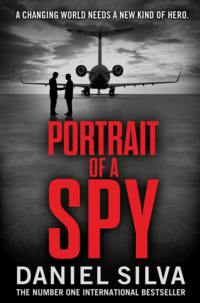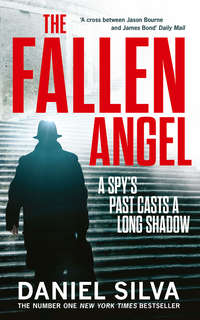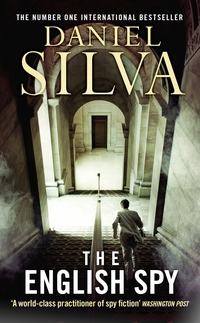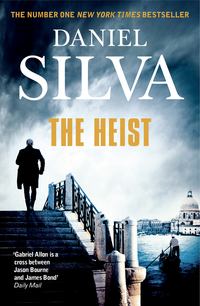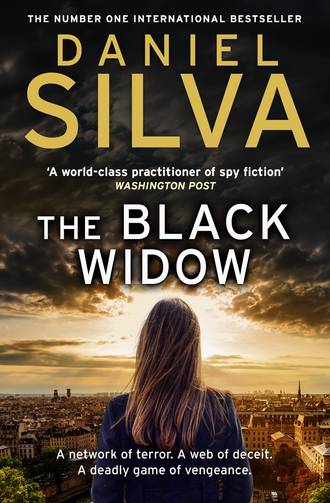
Полная версия
The Black Widow
His appearance at the museum, on a black and wet Wednesday in December a few days after the birth of his children, had come as a shock, and a profound relief, to the rest of the conservation staff. They had been warned he did not like to be observed while working. Still, they routinely poked their heads into his little curtained grotto merely to glimpse the altarpiece with their own eyes. Truth be told, he couldn’t blame them. The painting, Caravaggio’s Nativity with St. Francis and St. Lawrence, was arguably the world’s most famous missing work of art. Stolen from the Oratorio di San Lorenzo in Palermo in October 1969, it was now formally in the possession of the Vatican. The Holy See had wisely decided to withhold news of the painting’s recovery until the restoration was complete. Like many Vatican pronouncements, the official version of events would bear little resemblance to the truth. It would not mention the fact that a legendary Israeli intelligence officer named Gabriel Allon had found the missing painting hanging in a church in the northern Italian town of Brienno. Nor would it mention that the same legendary intelligence officer had been entrusted with the task of restoring it.
During his long career he had carried out several unusual restorations—he had once repaired a Rembrandt portrait that had been pierced by a bullet—but the Caravaggio altarpiece propped upon Gabriel’s easels was without question the most damaged canvas he had ever seen. Little was known of its long journey from the Oratorio di San Lorenzo to the church where he had found it. The stories, however, were legion. It had been kept by a Mafia don as a prize and brought out for important meetings of his henchmen. It had been chewed by rats, damaged in a flood, and burned in a fire. Gabriel was certain of only one thing: the painting’s wounds, while grievous, were not fatal. But Ephraim Cohen, the museum’s chief of conservation, was dubious. Upon seeing the painting for the first time, he advised Gabriel to administer last rites and return the altarpiece to the Vatican in the same wooden coffin in which it had arrived.
“Ye of little faith,” Gabriel had said.
“No,” replied Cohen. “Me of limited talent.”
Cohen, like the other members of the staff, had heard the stories—the stories of deadlines missed, of commissions abandoned, of church reopenings delayed. The snail-like pace of Gabriel’s work habits was legendary, almost as legendary as his exploits on the secret battlefields of Europe and the Middle East. But they soon discovered that his slowness was voluntary rather than instinctive. The craft of restoration, he explained to Cohen one evening while swiftly repairing the tattered face of Saint Francis, was a bit like making love. It was best done slowly and with painstaking attention to detail, with occasional breaks for rest and refreshment. But in a pinch, if the craftsman and his subject matter were adequately acquainted, a restoration could be done at extraordinary speed, with more or less the same result.
“You and Caravaggio are old friends?” asked Cohen.
“We’ve collaborated in the past.”
“So the rumors are true then?”
Gabriel had been painting with his right hand. Now he moved the brush to his left and worked with equal dexterity.
“What rumors are those?” he asked after a moment.
“That you were the one who restored the Deposition for the Vatican Museums a few years ago.”
“You should never listen to rumors, Ephraim, especially when they concern me.”
“Or the news,” said Cohen darkly.
His hours were erratic and unpredictable. An entire day might pass with no sign of him. Then Cohen would arrive at the museum to find a large portion of the canvas miraculously restored. Surely, he thought, he had a secret helper. Or perhaps Caravaggio himself was stealing into the museum at night, a sword in one hand, a brush in the other, to assist with the work. After one nocturnal session—a particularly productive visit during which the Virgin was returned to her former glory—Cohen actually checked the security footage. He found that Gabriel had entered the lab at half past ten in the evening and had departed at seven twenty the next morning. Not even the fawn-eyed bodyguard had been with him. Perhaps it was true, thought Cohen, as he watched the ghostly figure moving at one frame per second along a half-lit hall. Perhaps he was an archangel after all.
When he was present during normal business hours, there was always music. La Bohème was a particular favorite. Indeed, he played it so often that Cohen, who spoke not a word of Italian, could soon sing “Che gelida manina” from memory. Once Gabriel entered his curtained grotto, he never reappeared until the session was complete. There were no strolls in the museum’s sculpture garden to clear his head, no trips to the staff lunchroom for a jolt of caffeine. Only the music, and the soft tap-tap-tap of his brush, and the occasional click of his Nikon camera as he recorded his relentless progress. Before leaving the laboratory he would clean his brushes and his palette and put his trolley in order—precisely, noted Cohen, so he would be able to detect whether anyone touched his things in his absence. Then the music would go silent, the halogen lamps would dim, and with little more than a cordial nod to the others he would be gone.
By early April, with the winter rains a memory and the days warm and bright, he was hurling himself headlong toward a finish line only he could see. All that remained was the winged angel of the Lord, an ivory-skinned boy who floated in the upper reaches of the composition. It was a curious choice to leave for last, thought Cohen, for the boy angel had suffered serious injury. His limbs were scarred by heavy paint losses, his white garment was in tatters. Only his right hand, which was pointed heavenward, was undamaged. Gabriel restored the angel in a series of marathon sessions. They were noteworthy for their silence—there was no music during this period—and for the fact that, as he was repairing the angel’s auburn hair, a large bomb exploded in Paris. He stood for a long time before the lab’s small television, his palette slowly drying, watching as the bodies were pulled from the rubble. And when a photograph of a woman named Hannah Weinberg appeared on the screen, he flinched as though struck by an invisible blow. Afterward, his expression darkened and his green eyes seemed to burn with anger. Cohen was tempted to ask the legend whether he had known the woman, but decided against it. One could talk to him about paintings and the weather, but when bombs exploded it was probably better to keep one’s distance.
On the last day, the day of Uzi Navot’s journey to Paris, Gabriel arrived at the lab before dawn and remained in his little grotto long after the museum had closed for the night. Ephraim Cohen found an excuse to stay late because he sensed the end was near and wanted to be present to witness it. Shortly after eight o’clock he heard the familiar sound of the legend laying his brush—a Winsor & Newton Series 7—on the aluminum tray of his trolley. Cohen peered furtively through the slender gap in the curtain and saw him standing before the canvas, a hand resting against his chin, his head tilted slightly to the side. He remained in the same position, motionless as the figures in the painting, until the fawn-eyed bodyguard entered the lab and pressed a mobile phone urgently into his palm. Reluctantly, he lifted it to his ear, listened in silence, and murmured something Cohen couldn’t quite make out. A moment later both he and the bodyguard were gone.
Alone, Ephraim Cohen slipped through the curtain and stood before the canvas, scarcely able to draw a breath. Finally, he plucked the Winsor & Newton paintbrush from the trolley and slipped it into the pocket of his smock. It wasn’t fair, he thought, as he doused the halogen lamps. Perhaps he really was an archangel after all.
6
MA’ALE HAHAMISHA, ISRAEL
THE OLD KIBBUTZ OF MA’ALE HAHAMISHA occupied a strategic hilltop in the craggy western approaches to Jerusalem, not far from the Arab town of Abu Ghosh. Founded during the Arab Revolt of 1936–39, it was one of fifty-seven so-called tower and stockade settlements hastily erected across British-ruled Palestine in a desperate bid to secure the Zionist endeavor and, ultimately, reclaim the ancient kingdom of Israel. It derived its name and very identity from an act of revenge. Translated into English, Ma’ale Hahamisha meant “the Ascent of the Five.” It was a not-so-subtle reminder that an Arab terrorist from a nearby village had died at the hands of five of the kibbutz’s Jews.
Despite the violent circumstances of its birth, the kibbutz grew prosperous from its cauliflower and peaches and its charming mountain hotel. Ari Shamron, the twice-former chief of the Office and éminence grise of Israeli intelligence, often used the hotel as a meeting place when King Saul Boulevard or a safe flat wouldn’t do. One such meeting occurred on a brilliant afternoon in September 1972. On that occasion Shamron’s reluctant guest was a promising young painter named Gabriel Allon, whom Shamron had plucked from the Bezalel Academy of Art and Design. The Palestinian terrorist group Black September had just murdered eleven Israeli athletes and coaches at the Olympic games in Munich, and Shamron wanted Gabriel, a native German speaker who had spent time in Europe, to serve as his instrument of vengeance. Gabriel, with the defiance of youth, had told Shamron to find someone else. And Shamron, not for the last time, had bent him to his will.
The operation was code-named Wrath of God, a phrase chosen by Shamron to give his undertaking the patina of divine sanction. For three years Gabriel and a small team of operatives stalked their prey across Western Europe and the Middle East, killing at night and in broad daylight, living in fear that at any moment they might be arrested by local authorities and charged as murderers. In all, twelve members of Black September died at their hands. Gabriel personally killed six of the terrorists with a .22-caliber Beretta pistol. Whenever possible, he shot his victims eleven times, one bullet for each murdered Jew. When finally he returned to Israel, his temples were gray from stress and exhaustion. Shamron called them smudges of ash on the prince of fire.
It had been Gabriel’s intention to resume his career as an artist, but each time he stood before a canvas he saw only the faces of the men he had killed. And so with Shamron’s blessing he traveled to Venice as an expatriate Italian named Mario Delvecchio to study restoration. When his apprenticeship was complete, he returned to the Office and to the waiting arms of Ari Shamron. Posing as a gifted if taciturn European-based art restorer, he eliminated some of Israel’s most dangerous foes—including Abu Jihad, Yasir Arafat’s talented second-in-command, whom he killed in front of his wife and children in Tunis. Arafat returned the favor by ordering a terrorist to place a bomb beneath Gabriel’s car in Vienna. The explosion killed his young son Daniel and seriously wounded Leah, his first wife. She resided now in a psychiatric hospital on the other side of the ridge from Ma’ale Hahamisha, trapped in a prison of memory and a body ravaged by fire. The hospital was located in the old Arab village of Deir Yassin, where Jewish fighters from the Irgun and Lehi paramilitary organizations massacred more than a hundred Palestinians on the night of April 9, 1948. It was a cruel irony—that the shattered wife of Israel’s avenging angel should reside among the ghosts of Deir Yassin—but such was life in the twice-Promised Land. The past was inescapable. Arab and Jew were bound together by hatred, blood, and victimhood. And for their punishment they would be forced to live together as feuding neighbors for all eternity.
The years after the bombing in Vienna were for Gabriel the lost years. He lived as a hermit in Cornwall, he wandered Europe quietly restoring paintings, he tried to forget. Eventually, Shamron came calling yet again, and the bond between Gabriel and the Office was renewed. Acting at his mentor’s behest, he carried off some of the most celebrated operations in the history of Israeli intelligence. His was the career against which all others would be measured, especially Uzi Navot’s. Like the Arabs and Jews of Palestine, Gabriel and Navot were inextricably bound. They were the sons of Ari Shamron, the trusted heirs of the service he had built and nurtured. Gabriel, the elder son, had been confident of the father’s love, but Navot had always struggled to win his approval. He had been given the job as chief only because Gabriel had turned it down. Now, remarried, a father once more, Gabriel was finally ready to assume his rightful place in the executive suite of King Saul Boulevard. For Uzi Navot it was a nakba, the word the Arabs used to describe the catastrophe of their flight from the land of Palestine.
The old hotel in Ma’ale Hahamisha was less than a mile from the 1967 border, and from its terrace restaurant it was possible to see the orderly yellow lights of Jewish settlements spilling down the hillside into the West Bank. The terrace was in darkness, except for a few windblown candles flickering dimly on the empty tables. Navot sat alone in a distant corner, the same corner where Shamron had been waiting on that September afternoon in 1972. Gabriel sat down next to him and turned up the collar of his leather jacket against the cold. Navot was silent. He was staring down at the lights of Har Adar, the first Israeli settlement over the old Green Line.
“Mazel tov,” he said at last.
“For what?”
“The painting,” said Navot. “I hear it’s almost finished.”
“Where did you hear a thing like that?”
“I’ve been monitoring your progress. So has the prime minister.” Navot regarded Gabriel through his small rimless spectacles. “Is it really done?”
“I think so.”
“What does that mean?”
“It means that I want to take one more look at it in the morning. If I like what I see, I’ll apply a coat of varnish and send it back to the Vatican.”
“And only ten days past your deadline.”
“Eleven, actually. But who’s counting?”
“I was.” Navot gave a rueful smile. “I enjoyed the reprieve, however brief.”
A silence descended between them. It was far from companionable.
“In case it’s slipped your mind,” Navot said at last, “it’s time for you to sign your new contract and move into my office. In fact, I was planning to pack up my things today, but I had to make one more trip as chief.”
“Where?”
“I had a piece of intelligence that I needed to share with our French brethren about the bombing of the Weinberg Center. I also wanted to make certain they were pursuing the perpetrators with appropriate vigor. After all, four Israeli citizens were killed, not to mention a woman who once did a very large favor for the Office.”
“Do they know about our links to her?”
“The French?”
“Yes, Uzi, the French.”
“I sent a team into her apartment to have a look around after the attack.”
“And?”
“The team found no mention of a certain Israeli intelligence officer who once borrowed her van Gogh in order to find a terrorist. Nor was there any reference to one Zizi al-Bakari, investment manager for the House of Saud and CEO of Jihad, Incorporated.” Navot paused, then added, “May he rest in peace.”
“What about the painting?”
“It was in its usual place. In hindsight, the team should have taken it.”
“Why?”
“As you no doubt remember, our Hannah was never married. No siblings, either. Her will was quite explicit when it came to the painting. Unfortunately, French intelligence got to her lawyer before he could make contact with us.”
“What are you talking about, Uzi?”
“It seems Hannah trusted only one person in the world to look after her van Gogh.”
“Who?”
“You, of course. But there’s just one problem,” Navot added. “The French have taken the painting hostage. And they’re asking a rather high ransom.”
“How much?”
“The French don’t want money, Gabriel. The French want you.”
7
MA’ALE HAHAMISHA, ISRAEL
NAVOT LAID A PHOTOGRAPH ON the table, a street in Beirut littered with the ancient debris of an antiquities gallery.
“I assume you saw this.”
Gabriel nodded slowly. He had read about Clovis Mansour’s death in the newspapers. Given the events in Paris, the bombing in Beirut had received only minor press coverage. Not a single news outlet attempted to link the two events, nor was there any suggestion in the media that Clovis Mansour was on the payroll of any foreign intelligence service. In point of fact, he received money from at least four: the CIA, MI6, the Jordanian GID, and the Office. Gabriel knew this because, in preparation for taking over as chief, he had been devouring briefing books on all current operations and assets.
“Clovis was one of our best sources in Beirut,” Navot was saying, “especially when it came to matters involving money. Lately, he’d been keeping an eye on ISIS’s involvement in the illicit antiquities trade, which is why he requested a crash meeting the day after the bomb exploded in Paris.”
“Who did you send?”
Navot answered.
“Since when is Mikhail an agent runner?”
Navot laid another photograph on the table. It had been taken by an overhead security camera and was of moderate quality. It showed two men sitting at a small round table. One was Clovis Mansour. As usual he was impeccably attired, but the man opposite looked as though he had borrowed clothing for the occasion. In the center of the table, resting on what appeared to be a swath of baize cloth, was a head, life-size, its eyes staring blankly into space. Gabriel recognized it as Roman in origin. He reckoned the poorly dressed man had more of the statue, perhaps the entire piece. The perfectly intact head was merely his calling card.
“There’s no date or time code.”
“It was the twenty-second of November, at four fifteen in the afternoon.”
“Who’s the chap with the Roman head?”
“His business card identified him as Iyad al-Hamzah.”
“Lebanese?”
“Syrian,” answered Navot. “Apparently, he rolled into town with a truckload of antiquities to sell—Greek, Roman, Persian, all high-quality, many bearing the telltale signs of recent excavation. Among the places he attempted to unload his wares was Gallerie Mansour. Clovis expressed interest in several items, but after making a few quiet inquiries he decided to take a pass.”
“Why?”
“Because the word on the street was that the gentleman from Syria was using the sale of looted antiquities to raise money for the Islamic State. Evidently, the money wasn’t intended for ISIS’s general fund. The Syrian gentleman was working on behalf of a high-ranking ISIS leader who was building a terror network capable of attacking targets in the West.”
“Does the ISIS leader have a name?”
“They call him Saladin.”
Gabriel looked up from the photograph. “How grandiose.”
“I couldn’t agree more.”
“I don’t suppose Clovis managed to learn his real name?”
“No such luck.”
“Where’s he from?”
“The senior ISIS commanders are all Iraqis. They regard the Syrians as pack mules.”
Gabriel looked down at the photograph again. “Why didn’t Clovis tell us about this sooner?”
“It seems to have slipped his mind.”
“Or maybe he’s lying.”
“Clovis Mansour? Lying? How could you suggest such a thing?”
“He’s a Lebanese antiquities dealer.”
“What’s your theory?” asked Navot.
“I have a feeling Clovis made a great deal of money selling those antiquities. And when a bomb exploded in the heart of Paris, he thought it might be wise to hedge his bets. So he came to us with a pretty story about how he was too virtuous to deal with the likes of ISIS.”
“That pretty story,” said Navot, “cost Clovis his life.”
“How do you know?”
“Because they killed Sami Haddad, too. I’ll spare you the photo.”
“Why just Clovis and Sami? Why not Mikhail, too?”
“I’ve been asking myself the same question.”
“And?”
“I don’t know why. I’m just glad they didn’t kill him. It would have ruined my going-away party.”
Gabriel returned the photograph. “How much did you tell the French?”
“Enough to let them know that the plot against the Weinberg Center originated in the caliphate. They weren’t surprised. In fact, they were already well aware of the Syrian connection. Both of the attackers traveled there during the past year. One is a Frenchwoman of Algerian descent. Her male accomplice is a Belgian national from the Molenbeek district of Brussels.”
“Belgium? How shocking,” said Gabriel derisively.
Thousands of Muslims from France, Britain, and Germany had traveled to Syria to fight alongside ISIS, but tiny Belgium had earned the dubious distinction of being Western Europe’s largest per capita supplier of manpower to the Islamic caliphate.
“Where are they now?” asked Gabriel.
“In a few minutes the French interior minister is going to announce they’re back in Syria.”
“How did they get there?”
“Air France to Istanbul on borrowed passports.”
“But of course.” There was a silence. Finally, Gabriel asked, “What does this have to do with me, Uzi?”
“The French are concerned that ISIS has managed to construct a sophisticated network on French soil.”
“Is that so?”
“The French are also concerned,” said Navot, ignoring the remark, “that this network intends to strike again in short order. Obviously, they would like to roll it up before the next attack. And they’d like you to help them do it.”
“Why me?”
“It seems you have an admirer inside the French security service. His name is Paul Rousseau. He runs a small operational unit called Alpha Group. He wants you to fly to Paris tomorrow morning for a meeting.”
“And if I don’t?”
“That painting will never leave French soil.”
“I’m supposed to meet with the prime minister tomorrow. He’s going to tell the world that I wasn’t killed in that bombing on the Brompton Road. He’s going to announce that I’m the new chief of the Office.”
“Yes,” said Navot dryly, “I know.”
“Maybe you should be the one to work with the French.”
“I suggested that.”
“And?”
“They only want you.” Navot paused, then added, “The story of my life.”
Gabriel tried and failed to suppress a smile.
“There is a silver lining to this,” Navot continued. “The prime minister thinks a joint operation with the French will help to repair our relations with a country that was once a valuable and trusted ally.”
“Diplomacy by special ops?”
“In so many words.”
“Well,” said Gabriel, “you and the prime minister seem to have it all worked out.”
“It was Paul Rousseau’s idea, not ours.”
“Was it really, Uzi?”
“What are you suggesting? That I engineered this to hold on to my job a little longer?”
“Did you?”
Navot waved his hand as though he were dispersing a foul odor. “Take the operation, Gabriel—for Hannah Weinberg, if for no other reason. Get inside the network. Find out who Saladin really is and where he’s operating. And then put him down before another bomb explodes.”
Gabriel gazed northward, toward the distant black mass of mountains separating Israel from what remained of Syria. “You don’t even know whether he really exists, Uzi. He’s only a rumor.”
“Someone planned that attack and moved the pieces into place under the noses of the French security services. It wasn’t a twenty-nine-year-old woman from the banlieues and her friend from Brussels. And it wasn’t a rumor.”
Navot’s phone flared like a match in the darkness. He raised it briefly to his ear before offering it to Gabriel.
“Who is it?”
“The prime minister.”



